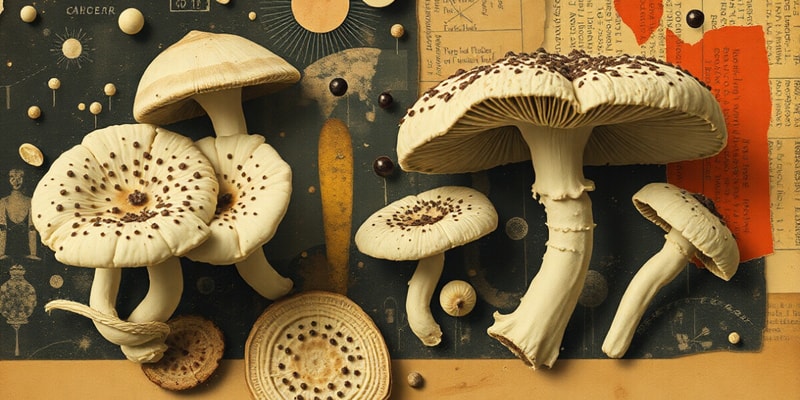Podcast
Questions and Answers
Which of the following are characteristics of fungi? (Select all that apply)
Which of the following are characteristics of fungi? (Select all that apply)
What is the basic structural unit of fungi?
What is the basic structural unit of fungi?
Hyphae
What are hyphal cell walls primarily composed of?
What are hyphal cell walls primarily composed of?
Chitin and glucan
How do fungi obtain nutrients?
How do fungi obtain nutrients?
Signup and view all the answers
Most fungi are motile.
Most fungi are motile.
Signup and view all the answers
Fungi reproduce through the production of ______.
Fungi reproduce through the production of ______.
Signup and view all the answers
Which type of reproduction can fungi perform?
Which type of reproduction can fungi perform?
Signup and view all the answers
What type of spores are produced by the sporangium?
What type of spores are produced by the sporangium?
Signup and view all the answers
What are the two main types of sexual reproduction in fungi?
What are the two main types of sexual reproduction in fungi?
Signup and view all the answers
All fungi are classified in the same taxonomic group.
All fungi are classified in the same taxonomic group.
Signup and view all the answers
What is a common example of a fungus from the Zygomycota group?
What is a common example of a fungus from the Zygomycota group?
Signup and view all the answers
Yeasts are a type of fungi that are usually ______.
Yeasts are a type of fungi that are usually ______.
Signup and view all the answers
Match the term to its definition:
Match the term to its definition:
Signup and view all the answers
What type of fungi are commonly used in the production of beer?
What type of fungi are commonly used in the production of beer?
Signup and view all the answers
Which of the following statements is true about Basidiomycota?
Which of the following statements is true about Basidiomycota?
Signup and view all the answers
Study Notes
Characteristics of Fungi
- Eukaryotic organisms with organelles, including microfilaments and tubules.
- Basic structural unit is hyphae, which can be aseptate (coenocytic) or septate.
- Cell walls consist of chitin and glucan, providing structural integrity.
- Fungi are heterotrophic, absorbing nutrients osmotrophically through the cytoplasmic membrane.
- Reproduce via spores, with both sexual and asexual processes.
- Majority of fungi are non-motile; exceptions include zoospores, which are motile.
Structure and Reproduction
- Hyphae form mycelium, a mass of branching filaments; vegetative structure termed thallus.
- Asexual reproduction involves spore-producing structures and germination of spores.
- Sexual reproduction includes steps such as plasmogamy, karyogamy, and meiosis, resulting in spore production.
Asexual Reproduction Types
- Hyphal growth allows vegetative parts to be transplanted and to continue growth.
- Asexual spore formation is categorized into sporangiospores (enclosed) and conidiospores (not enclosed).
- Yeasts reproduce by budding, differentiating them from other fungal forms.
Taxonomy of Fungi
- Taxonomy is continuously evolving and includes groups like Chytridiomycota, Zygomycota, Glomeromycota, Ascomycota, and Basidiomycota.
- The classification is based on reproduction and molecular analysis, with approximately 90,000 species described (potentially 1.5 million).
Zygomycota
- Commonly known as zygomycetes, primarily saprophytes with some being parasites.
- Characterized by coenocytic hyphae and the ability to produce zygosporangium containing zygospores.
Ascomycota
- Known as ascomycetes, characterized by cup-shaped structures (ascocarps).
- Includes significant groups such as yeasts and truffles, primarily saprophytic.
Basidiomycota
- Refer to as club fungi, notable for basidiospores produced in basidia.
- Most species are saprophytic, with some being significant pathogens or toxic to humans.
Ecological Roles of Fungi
- Serve as essential decomposers, breaking down organic matter and recycling nutrients (C, N, P).
- Act as disease agents for plants, animals, and humans, with varying levels of severity.
Symbiotic Relationships
- Form lichens in association with algae or cyanobacteria, enhancing survival in harsh environments.
- Mycorrhizae are beneficial associations with plants, facilitating nutrient exchange.
Fungi in Industry
- Used widely in the production of food and beverages such as bread, wine, beer, and cheese.
- Produce important pharmaceuticals like antibiotics (e.g., penicillin) and industrial chemicals.
Disease Overview
- Superficial infections (e.g., black piedra) affect hair and skin.
- Cutaneous infections include conditions like athlete's foot (Tinea pedis).
- Subcutaneous infections result in diseases such as sporotrichosis.
- Systemic infections can cause severe issues, exemplified by histoplasmosis (Histoplasma capsulatum).
Studying That Suits You
Use AI to generate personalized quizzes and flashcards to suit your learning preferences.
Description
Explore the fascinating world of fungi with this flashcard quiz, focusing on their characteristics and functions. Learn about their structure, reproduction, and ecological roles through detailed definitions and examples.



